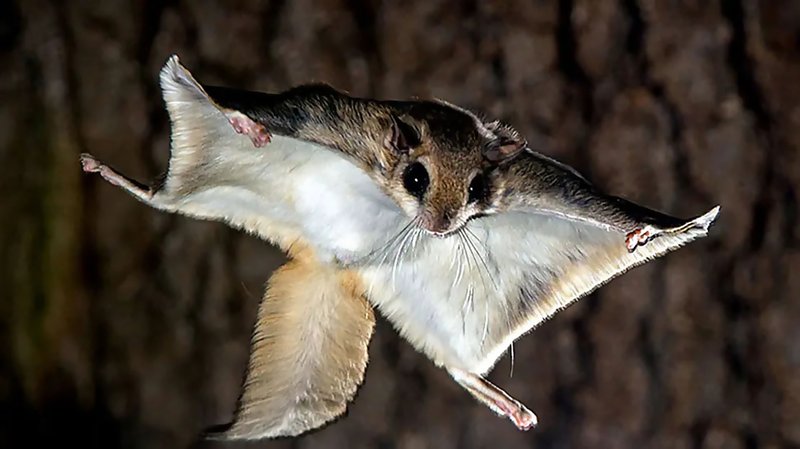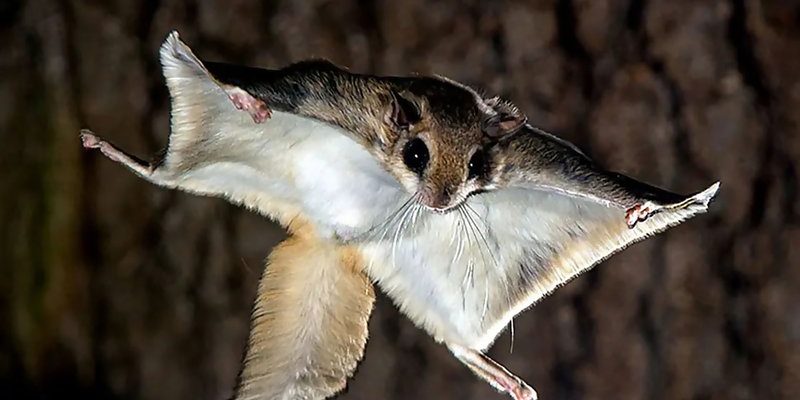
Flying squirrels belong to the family Sciuridae, which is a fancy way of saying they’re related to those cute little gray squirrels we see in our yards. However, these little guys have a special talent: they can glide between trees with ease. Imagine if you could leap from one building to another, using your arms to catch the wind! Let’s dive into some amazing facts that will make you appreciate these unique little gliders even more.
1. They Can Glide Over 150 Feet!
Flying squirrels are truly remarkable in the distance they can cover in a single glide. With their special membrane, called the patagium, stretching from their wrists to their ankles, they can soar up to 150 feet—about the length of half a football field! This membrane acts like an umbrella, catching the air and allowing them to drift smoothly from tree to tree.
Think about it: if you were to leap off a high branch, you could glide down to the ground. For them, it’s like flying through the air, turning and maneuvering with ease. This ability helps them travel easily between trees, escape predators, and find food. Imagine soaring between trees at night; that’s what these little creatures do!
2. They’ve Got Some Serious Night Vision
Flying squirrels are nocturnal, which means they’re most active at night. To help them navigate in the dark, they have incredible night vision. Their large, dark eyes are designed to capture as much light as possible, which gives them an advantage when finding food or avoiding predators.
Picture this: walking through a dark forest at night. Without proper light, it might be difficult to see where you’re going. However, flying squirrels can see just fine! Their eyes help them maneuver through the treetops, searching for fruits, nuts, and tree sap. This nocturnal lifestyle not only keeps them safe from many daytime predators but also allows them to exploit food resources that other animals might miss.
3. They’re Social Creatures
Flying squirrels often live in small family groups, making them quite social. They communicate using a variety of sounds, including soft chirps and even barks! This social behavior is vital for their survival. By sticking together, they can help fend off predators and keep each other safe from harm.
Imagine a tight-knit community where everyone looks out for one another. That’s what flying squirrels do! They often share nests, which are built in tree hollows or abandoned cavities, providing warmth and safety for their young. They might even snuggle up to each other during cold nights, which is adorable, right?
4. They Can’t Actually Fly
You might be surprised to learn that flying squirrels can’t really fly like birds. Instead, they can glide. Their bodies are designed for gliding rather than flying. They don’t have wings, but their membrane allows them to create lift and control their direction.
Just like a hang glider catches the wind, flying squirrels use their body to navigate through the air. They can steer by moving their legs and using their tails for balance. So, while they don’t have the power of flapping wings, they’re masters of gliding gracefully from tree to tree.
5. Their Teeth Never Stop Growing
Like many rodents, the teeth of flying squirrels never stop growing! This constant growth means they need to chew on hard surfaces like bark and wood to keep their teeth worn down. If they don’t, their teeth could grow too long, making eating difficult.
You might think of it like maintaining a lawn. Just as you have to trim the grass to keep it manageable, flying squirrels must gnaw on things to keep their teeth healthy. This keeps their smiles looking good and allows them to eat a varied diet of fruits, nuts, and even insects!
6. They Have a Unique Way to Move
When it comes to traveling on the ground, flying squirrels aren’t great at running. Instead, they tend to move in a unique way, using their hind legs to hop or even glide short distances. This may seem clumsy compared to other animals, but it works for them!
Think of it like a person trying to navigate a busy sidewalk with a skateboard. It can be a bit tricky! But when these squirrels are up high in trees, their gliding skills shine. Their specialized movement keeps them safe from predators while they’re searching for food in the treetops.
7. They’re Found in Many Different Places
Flying squirrels are not limited to just one region; they can be found in various parts of the world! There are about 50 species of flying squirrels, and they inhabit places in North America, Asia, and beyond. Each species has adapted to its environment, whether it’s the dense forests of North America or the tropical forests in Southeast Asia.
Imagine exploring different countries and spotting diverse flying squirrels in their natural habitats. From thick forests to mountain ranges, these little gliders are thriving in many ecosystems. They contribute to the health of their environments by helping disperse seeds, which promotes plant growth.
8. Their Nests Are Cozy Homes
Flying squirrels love to make cozy nests, often using materials like leaves, fur, and moss to keep warm. They typically find tree hollows to build their nests, making them snug and safe from the elements.
Think of it like an airtight sleeping bag with all the comforts of home! These nests not only provide shelter for the adult squirrels but are also essential for raising their young. If you ever spot one of these nests high in the tree, you can bet it’s filled with warmth and love!
9. They Play a Role in Their Ecosystem
As small mammals, flying squirrels play an essential part in their ecosystem. By eating fruits, nuts, and seeds, they help with seed dispersal. When they consume these food sources, they often move on to different areas, leaving seeds behind to sprout into new plants.
Imagine tiny gardeners working to cultivate new life in the forest! This process is crucial for maintaining forest health and ensuring there’s plenty of food for other animals as well. Their role in nature is vital, even if they’re often overlooked.
10. They Have a Unique Defense Mechanism
When it comes to avoiding predators, flying squirrels have a few tricks up their sleeves. They can emit high-pitched sounds to alert other squirrels about dangers. Additionally, their gliding abilities help them escape quickly when spotted.
Consider this: if you saw a predator nearby, wouldn’t you want to get away fast? These little creatures make a quick escape by gliding down to the next tree. They also rely on their excellent camouflage to blend in with their surroundings. So, when they’re resting in a tree, they can be pretty hard to spot!
In conclusion, flying squirrels may look cute and fuzzy, but they are incredibly fascinating creatures with remarkable adaptations for survival. From their impressive gliding abilities to their social behavior, there’s so much to appreciate about these critters. Next time you hear a rustle in the trees, remember that it just might be a flying squirrel, gliding gracefully through its nighttime kingdom.

